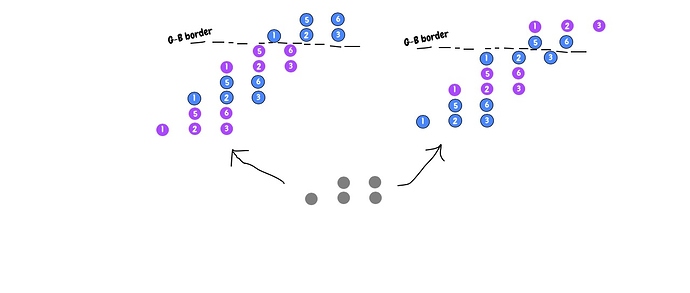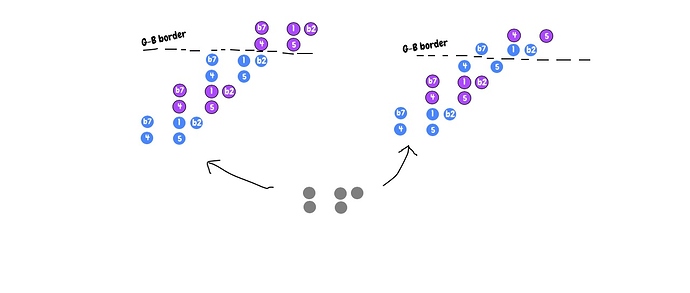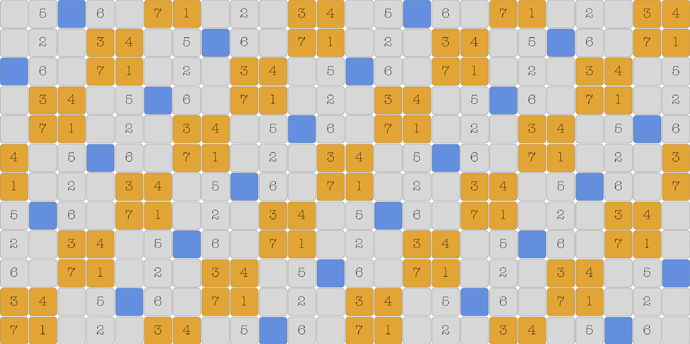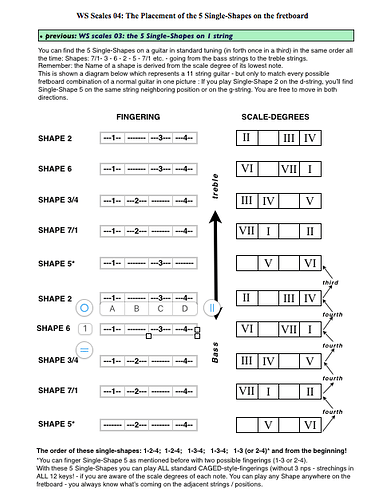@Frylock, in my case the neck is visualized as chromatic pitch names. Singing those pitches I use solfege. Singable note names that change depending on function, context, and goal of the moment. Similar to the way one sees any visualization patterns overlayed upon pitch names. Cheers, D
Since you change your singable note names depending on function/context/goal, what do use for “chromatic pitch names”? Ascending solfege names, or something else? Or do function-agnostic “chromatic pitch names” not have a prominent role in your thinking?
Well, originally I used fixed ‘do’, descending syllable chromatic solfege in my ear training experiments in an effort to sort of wear patterns in my awareness. That seemed a longer way to nirvana at some point. Furthermore my mental map of the fretboard predates any of that. But regardless, I only use the solfege to express key-agnostic ideas in conversation with other musicians, and when singing lines. So I think the latter?
Given three notes, let’s say A, B, and C. That boils down into M2 and m2 in my thinking, and that in turn may be sung using any number of syllables in context, depending on say, if I’m singing roots of a progression or memorizing a solo.
These deserve three lines of their own. They are not equivalent.
@Frylock, regarding a question I saw asked on a different thread, did you ever end up checking out the Bruno instructional videos? My takeaway from those (and it’s been a long time since I rented (!) them) is that I enjoyed that he presented a fully formed system of fretboard organization that built on position playing with his own auxiliary patterns. I don’t recall which of the two that was. In the interview for CtC he emphasized five positions, but his concept goes beyond that. Well worth a watch.
They’re close enough to group together, and depending on where you get the information pretty much the same (if not in spirit, in fingering) mostly 3 note per string (half whole or whole half) with a string or two having 2 (always a whole step) notes to keep everything in position, typically without using stretches.
If we’re talking about diatonic modes, of course.
I own Fretboard Logic (maybe the most popular book where the whole CAGED thing was explained?), god only knows how many guitar methods and was in the first Jimmy Bruno online school for years, where he reworked most of his material in the DVDs (that I also own) in a different non modal direction mainly based on the five Major Scale fingerings.
Feel free to expand on them, discussion is always welcomed.
Very interesting, and very cool.
On the other stuff, I really do think they deserve their own line in a discussion like this for the very same reason you just illustrated. Certainly they’re related as variations on position playing, but if we’re outlining the schools and getting at the nuance of this stuff as we do with picking, why would we wanted to apply the language of the Fretboard Logic school to folks coming out of Berklee, or classical schools? Especially when in advanced application, the fundamentals of the different approaches fall away. If we’re looking at where folks started, I think they are important in their diversity.
I don’t know, is Bruno a fan of the Fretboard Logic book? Why would anybody want to be defined or boxed in that way? The “Grady” approaches include the essence of Malmsteen’s and Johnson’s practice, but I don’t think they needed what @Troy went through to achieve facility. Was Bruno not answering different questions with the iterations of his systems? And wishing the man health, by the way!
Are we talking about diatonic modes? The “modal” view of the world set me back for decades in terms of ways to get at it all. The view isn’t wrong, necessarily (ducks), but what it teaches us by itself can only get one so far.
Segovia isn’t in your list, but Pebber Brown and Chuck Loeb are? (Cool, folks to Google!) Perhaps that list was intended to convey categories? I can buy that one could group “caged/traditional/Jimmy Bruno” under position playing, but I think it’s easier to split them out (1) given the silly 3nps versus “CAGED” arguments out there, and (2) so many alternatives worth mentioning.
My first FordScale approach looks a lot like 3nps, but functions more like Lego bricks when viewed as two patterns and taught as I teach it. My later FordScale approach involves six note per string chromatic scales starting on the pitch A. Not sure if it fits under the ones already listed? In terms of the patterns they imply, they are nearly opposites in application. I only group them together in my mind as reflecting different answers to the questions I faced along the way.
Wholehearted agreement on the utility to the musician. 
“Alternatives worth mentioning” that’s what this post is exactly about hehe.
Segovia scales really feel like fragments of other systems to me, I may not mention it on the first post but I’m more than a little bit biased towards improv since that’s “my thing”.
I have a very advanced classical guitarist friend, who studied at the Mozarteum in Vienna and he told me when someone was trying some really awful looking fingerings the running joke was “are those Segovia fingerings?” so that’s some food for thought…
Pebber Brown taught Brian Carroll aka Buckethead (for 10 years, before Gilbert) and also studied with Dick Grove, I learned from him online for a while many years ago and his stuff is very structured, almost too structured even hehehe. Tons of stuff to learn, or at least ponder about, on his Youtube channel.
Chuck Loeb… I met 3 times before he passed last year and we hanged at dinner after concerts every time so I got a first row chance to pick his brain for hours sometimes, one of the nicest people I’ve ever met as well as an amazing musician and performer.
I don’t even use any of these methods myself nowadays, I kinda build octaves like legos of whatever I need really, usually in 3nps (for 7 note scales or modes) or 2nps (for pentatonics).
No ear = no good 
Ha, sounds like music school shade. Lots of folks using similarly constructed patterns to great effect–while improvising.
Likewise the “mappings” to the fretboard are pretty much a non-issue for me at this point. My head stays in the music space, and for that I’m thankful. Interest in ear training becomes an imperative.
Yup. 
No, but they’re definitely on “the list”.
This is very cool to note.
And hopefully the numbers are making more sense? I don’t know who did this drawing. I drew hundreds of similar ones playing with it back in the day, and again would like to note that they don’t have to stack up in the familiar three-note per string arrangement.
So as to not dominate this topic, I moved my FordScales discussion to a separate thread. @patternblue, I’d still be very interested to know who else was teaching this way? Are you the blue pattern? I kind of expected that in the age of finger controllers and readily accessible videos by tuned-in-fourths folks like Tom Quayle that I’d have seen someone charting stuff out this way too by now.
I’ll throw it out there that Derryl Gabel’s got some very interesting ways of organizing pentatonics. (And as always he’s a fantastic resource on Holdsworthian approaches and tone as well.)
And while thinking about @AGTG’s synthetic scale, I was reminded of scale systems that vary in different octave ranges.
In particular, Larry Carlton’s sequence of major and minor that carries one further “out” the farther one plays into the scale.
More of an abstraction, these approaches live within the others.
Hi RockStarJazzCat, I made the drawing in sketch.io.
No one taught me this. I came across a similar chart in a Reddit thread, which I can’t find anymore.
I like exploring isomorphic instruments (instruments with uniform layouts). E.g. Ableton Push pads, Perfect Fourths tuned guitar, violin, bass guitar, etc. I hate not being able to simply plane a chord without changing the shape (e.g. piano).
I wouldn’t recommend applying this concept for every scale on guitar though. You still have to memorize all the different variations that cross over the pesky G-B string border.
But for some 5-note shapes, I came up with these repeating “323-nps” patterns.
For example, this pentatonic scale:
And this Japanese scale I like called “In Sen” (1, b2, 4, 5, b7):
What’s cool is that there are only 2 variants depending on which part crosses the G-B border.
That’s great, @patternblue! And thanks for responding. And how funny that your exploration led you to exploring other cells that actually happen to live in what I’ve explored in my later system! They’re all right there to think about, but again, extremely rare to see expressed or taught. Synchronicity. 
Re your pentatonic patterns, take a look at what I posted yesterday…!
FordScales - What the heck is "FordScales?" - #23 by RockStarJazzCat
Goodrick talks about “moveable mini positions” in The Advancing Guitarist, which is akin to what we’ve explored independently (session guitarist Sandy Williams recommended that book to me in 1990). My later system isn’t so much about moveable than being about knowable everywhwere by virtue of living in a chromatic bounds.
Sequencing one of your example patterns through the later system yields 12 patterns in essentially one 6nps, two-string, chromatic cell. We never really get away from the “12 notes” but at least we can limit the “5 x 12” where we do the work five times without acknowledging the symmetry. 
Exactly what I was referring to about these things becoming more obvious in the days of “finger controllers.” I’ve practiced some on Push, on the ironic side of bringing what I’ve learned from guitar to the same. Still a lot to be explored regarding the isomorphic instruments for sure.
Joshua, would you talk a bit about this “Say It as You Play It” exercise?
Sure!
- put on a C drone or simple C major backing track.
- on just one string, identify the locations of the notes of C major (CDEFGAB)
- now slowly solo using one finger, saying the name of the notes OUT LOUD as you play them
You’re creating a clear link in your mind between a note and its name. It helps move away from thinking of notes as a series of coordinates.
I tune in 4ths and invented my own navigation system. This should give you the idea, there are a whole bunch of extra strings on this “guitar” (they’re horizontal) to show the pattern of the orange boxes, and my movement is always based on them. The numbers in each box are the note in the major scale. A regular tuning shears the highest two strings and breaks the symmetry, but I suppose that some people like grand barre chords… for me, I don’t really play chords with more than 4 strings, so 4ths is OK for what I do.
The beauty of the guitar layout is that there are 5 different strings, producing 5 different basic chords, 5 different scale shapes on 1 string ( no stretching), which can be organised in the 5 main position fingerings like CAGED - in always the same order with 5 different starting points. You can organise two of these single-shapes into a mini-shape (Dweezil Zappa calls the pentatonic variant of these the “shapes of freedom”, Goodrick calls them “Moveable Mini Positions”) which are the core idea of diagonal fingerings in octave displacements. And if you want to to play in octave range - shape simply use three of these single-Shapes - the order will never change.
@ kgk - you can still have this beautiful system in standard tuning as long as you are aware of the one string tuned differently. You just go one fret to the right, as with an open power chord in D vs. A or E.
The core idea: the fingerings always repeat in the same order.
I quickly translated the sheet into english - hope it makes sense!
The discussion made me think of my early years on the classical guitar, playing master pieces like Villa-Lobos with no clue what’s going on - and later getting together a complete navigation system with no clue what to play when it came to improvising… 
But regarding the old pieces every shape got a meaning, like ah - look! this G-shape in d-major reminds me of Villa-Lobos Prelude No.5 etc.
Best wishes and an awesome thread!




